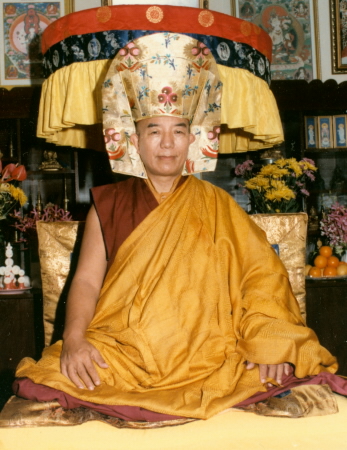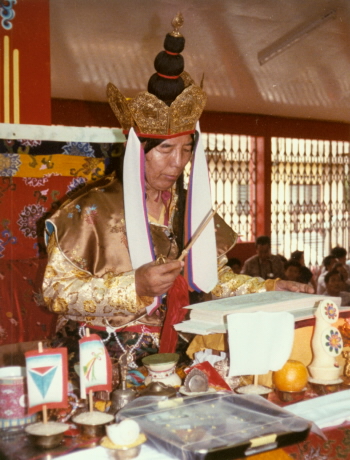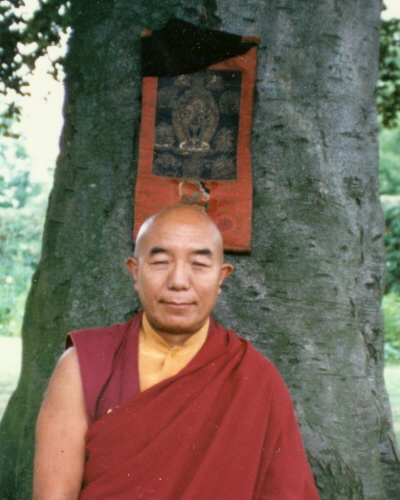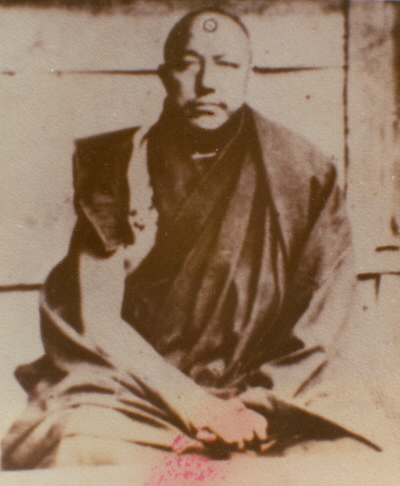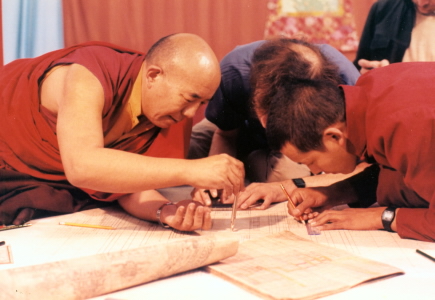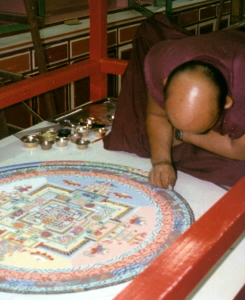Kālacakra empowerment
Marking the tenth anniversary of the establishment of his Buddhist centre in Grabnik, Poland, Ven. Tenga Rinpoche performed a major Kālacakra empowerment, "The
Seven Empowerments Raising the Child", together with the three abbreviated Ultimate Empowerments. This was the first time that this initiation had been given in its full form in Poland.Tenga Rinpoche is one of the foremost teachers of the Karma Kagyu tradition, and was for many years the Vajra-master (rdo rje slob dpon) at Rumtek monastery in Sikkim, the Indian seat of His Holiness Gyalwa Karmapa, head of the Karma Kagyu tradition. The empowerment that Rinpoche gave in Poland is from the main tradition passed in the Karma Kagyu school. This lineage was originally derived from the Jonang tradition, and was later developed in the Karma Kagyu by the famous Jamgon Kongtrul. The text that Tenga Rinpoche will use for the empowerment (ye shes rgya mtsho'i bcud 'dren) was written by Jamgon Kongtrul, based on the earlier work of the Jonangpas Dolpopa Sherab Gyaltsen and Tāranātha. This empowerment was first given in the west (1982) by Ven. Kalu Rinpoche, himself considered an emanation of Jamgon Kongtrul. Kalu Rinpoche passed the tradition on to Bokar Rinpoche and other Kagyu lamas such as Tenga Rinpoche. The empowerment is preceeded by a few days of preparation, including the drawing of a powder maṇḍala of Kālacakra, and the performance of the great ritual of Kālacakra (ye shes rgya mtsho) written by Tāranātha. See below for some further details regarding Tenga Rinpoche. Karma Kamtzang Meditation Center Grabnik 4, 96-313 Jaktorow phone: (+48 46) 856 49 69 fax: (+48 46) 856 49 70 e-mail: benchen@benchen.org.pl Internet site: www.benchen.org.pl, and, www.kalachakra.org.pl. Click here for some explanations of the structure of the Kālacakra empowerment. Also, see www.benchen.org for further details regarding the activities of Tenga Rinpoche. Short history of Benchen monastery and the Tenga Rinpoche incarnations
One day, whilst he was standing by a large rock, a large black raven descended from the sky, landed on the rock and started to make a loud noise. Gelek Gyatso moved closer to look at the raven and saw it drop from its mouth a small turquoise image of the protector Dorje Bernagchen, and then dance around on top of the rock. He realised that the raven itself must be an emanation of the protector, and, as this was a particularly good omen, decided that this would certainly be the site for his monastery. He kept the small image of Mahākāla for the shrine of the future monastery. The local chief of the area, Rarda Pontsong, an ancestor of the present Rarda Lama, Chime Rinpoche, was approached by Gelek Gyatso; he related to him his story and requested that the necessary land be made available to him for the construction of the monastery. Rarda Pontsong was deeply impressed and enthusiastically gave the very land on which the large black tent that was his family home stood, saying that he would help with the project in any way that he could. During the subsequent building of the monastery many great gales, hail storms and strange manifestations occurred, upsetting the progress of the work, and these were finally realised by Gelek Gyatso as possibly being caused by the displeasure of the protector of the Rarda family. He told Rarda Pontsong of the problems and having learned from him that the family's protector was Shing Chong (zhing skyong), resolved that he would dedicate himself to the meditation on this protector and that Shing Chong should always be the protector of his teachings. He built a shrine for Shing Chong, who remains to this day the special protector of all those associated with Benchen monastery, and having done this, the building work was completed without further obstacle. The story of the Tenga incarnations (bstan dga' sku phreng), starts at the time of the eighth Sangje Nyenpa, Tendzin Drupchok, one of whose students was a highly accomplished Lama called Gonkhen Samten. The title Gonkhen (mgon mkhan) means "protector expert", and was given to him as he was considered so proficient in Shing Chong meditation. He spent most of his life in retreat, meditating on his yidam, Karma Pakshi, and Shing Chong. He received many people who came to him for his blessing, which could cure all sorts of medical and other problems. Several years after Lama Samten died, Tendzin Drupchok, while travelling on the road to Lhasa, met with another local chief, Drungpa Pontsong, who requested from him various empowerments. For several days he accepted the hospitality of Drungpa, during which time he met a small boy in the family, who asked Sangje Nyenpa if he would return to him his thighbone trumpet. Tendzin Drupchok immediately remembered that shortly before he died Lama Samten had given him his thighbone trumpet, asking him to look after it for a while. He realised that the little boy must be the new incarnation of Lama Samten. A couple of years later, after he had completed his travels in the Lhasa area and was about to return to Benchen, the boy was given to Tendzin Drupchok by Drungpa and travelled with him to Benchen. From soon after his arrival at the monastery until he was a young man, the boy studied the theory and practices of the Karma Kagyu tradition, completing, among other things, the memorisation of all the rituals and songs used at Benchen monastery in the space of just one year. During this period of time he received ordination from Tendzin Drupchok and was given the name Karma Tendzin Chogyal. When he was about eighteen years old Tendzin Drupchok told him about Lama Samten and that as he had been such a distinguished Lama, he held high hopes for his future. He told him that in order to fulfil those hopes he should do a good retreat, and suggested that this would be best done under the direction of the great Jamgon Kongtrul.
By the time he returned to Benchen Tendzin Drupchok had died, so Tendzin Chogyal had to take over the running of the monastery and the education of the new Sangje Nyenpa, Gelek Druppe Nyima. During the rest of his life one of his most important acts was to build at Benchen four retreat centres, for Jinasāgara (rgyal ba rgya mtsho), Sarvavid Vairocana (kun rig rnam par snang mdzad, this retreat also included meditation on White Tārā and Shing Chong), the Six Dharmas of Nāropa, and, the Six Dharmas of Niguma. When Tendzin Chogyal was an old man he told his monks that as he was now old and that things were becoming difficult for him, he would leave Benchen and go and live in "some pleasant gardens". They all sympathised and considered this a very good idea. He told Sangje Nyenpa Rinpoche the same and gave him some of his possessions, including the painting of Six-armed Mahākāla, to look after for him while he was away. A few days later, he passed away.
After a search for the child the present Tenga Rinpoche was found, aged seven, and assumed his studies at Benchen, receiving refuge, and the name Karma Tendzin Thinle Namgyal, from Situ Rinpoche. He was installed as a tulku at age sixteen and a couple of years later took the opportunity of learning medicine from an uncle who was both a lama and a doctor. At age nineteen he received ordination from Situ Rinpoche at Pepung monastery and a few years later, after his studies were completed, he entered retreat for three years. During his retreat he became particularly adept at the meditation of White Tārā (his personal yidam) and Tummo (a perfection process mediation, often known as "inner heat"). Regarding the latter, it is said that he was the only person in the retreat whose water offering bowls did not freeze over during the winter, and whose retreat cell remaining clear of snow. The Chinese invasion occurred in 1959, and Tenga Rinpoche, together with Chime Rinpoche and others, left Benchen, first for Lhasa, and then Kalimpong in northern India. He stayed there for a year and a half and then went to Rumtek, where a new monastery was being constructed by His Holiness Karmapa. There he studied all the ritual methods of Tsurphu (mtshur phu) monastery, the original seat of the Karmapas, and was eventually made Vajra-master of Rumtek. Arthritis developed in one of his feet, and this got so bad that he was forced to leave Rumtek in search of effective medical treatment. He stayed first in Darjeeling for a few months, and then, a few weeks after performing a Kālacakra empowerment in May 1976, he travelled to Kathmandu, Nepal. He settled in the Svayambhū area, and established first a small retreat centre, and then later a major monastery, the Kathmandu "branch" of the original Benchen monastery in eastern Tibet. In 1974, a couple of years before he settled in Kathmandu, Tenga Rinpoche travelled to the west for the first time as part of the entourage of His Holiness Karmapa. Later, in 1978, he travelled to the west in his own right to teach, first in Copenhagen, and then extensively around many countries in Europe, in particular Germany. His visits to Europe have continued regularly since that time, and as a result his own Buddhist centre was established in 2000, at Allmuthen, on the border between Belgium and Germany.
Last updated 4 February 2010. Return to Home Page. |
